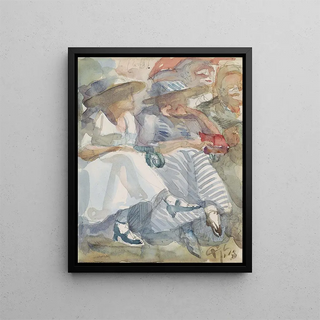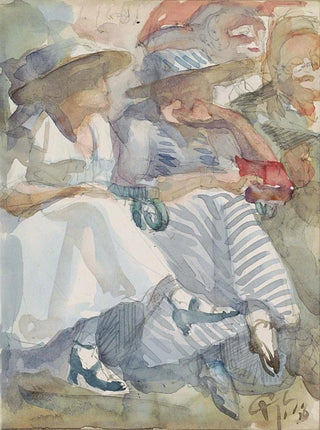Art print | Two women seated in the front row in an audience - Reijer Stolk Source: Reproduction | Deux femmes assises au premier rang dans un public - Reijer Stolk


View from behind

Frame (optional)
Reijer Stolk's artwork, "Two women sitting in the front row in an audience," is a true invitation to immerse oneself in the fascinating world of 19th-century Dutch painting. This art print, while preserving the authenticity of the original work, allows for an appreciation of the subtlety of details and the richness of colors that characterize Stolk's work. The two women, sitting with tranquil grace, capture the viewer's attention and evoke curiosity about their story and environment. The scene, imbued with an intimate atmosphere, transports us to a moment of life frozen in time, where each element seems to tell a story.
Style and uniqueness of the work
Stolk's style is distinguished by his ability to blend realism and sensitivity. In this piece, the delicate features of the two women's faces are highlighted by subtle lighting that enhances the nuances of their expressions. The composition, carefully balanced, guides the eye across the painting, revealing details often overlooked in the bustle of an audience. The clothing of the protagonists, of refined elegance, reflects the fashion trends of the period, while adding a narrative dimension to the scene. Stolk manages to capture not only the external appearance of his subjects but also a part of their inner essence, making his work deeply emotional and human.
The artist and his influence
Reijer Stolk, a Dutch painter of the 19th century, established himself as a significant figure of his time. Influenced by the masters of classical painting, he developed a style that is uniquely his own, combining tradition and innovation. His attention to detail and sense of color allowed him to create works that still resonate today. Stolk was also an observer of the customs and behaviors of his era, which is reflected in his compositions. By depicting scenes of daily life, he invites the viewer to reflect on the social and cultural dynamics of his time, making his work a mirror of the aspirations and concerns of 19th-century Dutch society.
An exceptional wall decoration signed Artem Legrand

Matte finish

View from behind

Frame (optional)
Reijer Stolk's artwork, "Two women sitting in the front row in an audience," is a true invitation to immerse oneself in the fascinating world of 19th-century Dutch painting. This art print, while preserving the authenticity of the original work, allows for an appreciation of the subtlety of details and the richness of colors that characterize Stolk's work. The two women, sitting with tranquil grace, capture the viewer's attention and evoke curiosity about their story and environment. The scene, imbued with an intimate atmosphere, transports us to a moment of life frozen in time, where each element seems to tell a story.
Style and uniqueness of the work
Stolk's style is distinguished by his ability to blend realism and sensitivity. In this piece, the delicate features of the two women's faces are highlighted by subtle lighting that enhances the nuances of their expressions. The composition, carefully balanced, guides the eye across the painting, revealing details often overlooked in the bustle of an audience. The clothing of the protagonists, of refined elegance, reflects the fashion trends of the period, while adding a narrative dimension to the scene. Stolk manages to capture not only the external appearance of his subjects but also a part of their inner essence, making his work deeply emotional and human.
The artist and his influence
Reijer Stolk, a Dutch painter of the 19th century, established himself as a significant figure of his time. Influenced by the masters of classical painting, he developed a style that is uniquely his own, combining tradition and innovation. His attention to detail and sense of color allowed him to create works that still resonate today. Stolk was also an observer of the customs and behaviors of his era, which is reflected in his compositions. By depicting scenes of daily life, he invites the viewer to reflect on the social and cultural dynamics of his time, making his work a mirror of the aspirations and concerns of 19th-century Dutch society.
An exceptional wall decoration signed Artem Legrand






